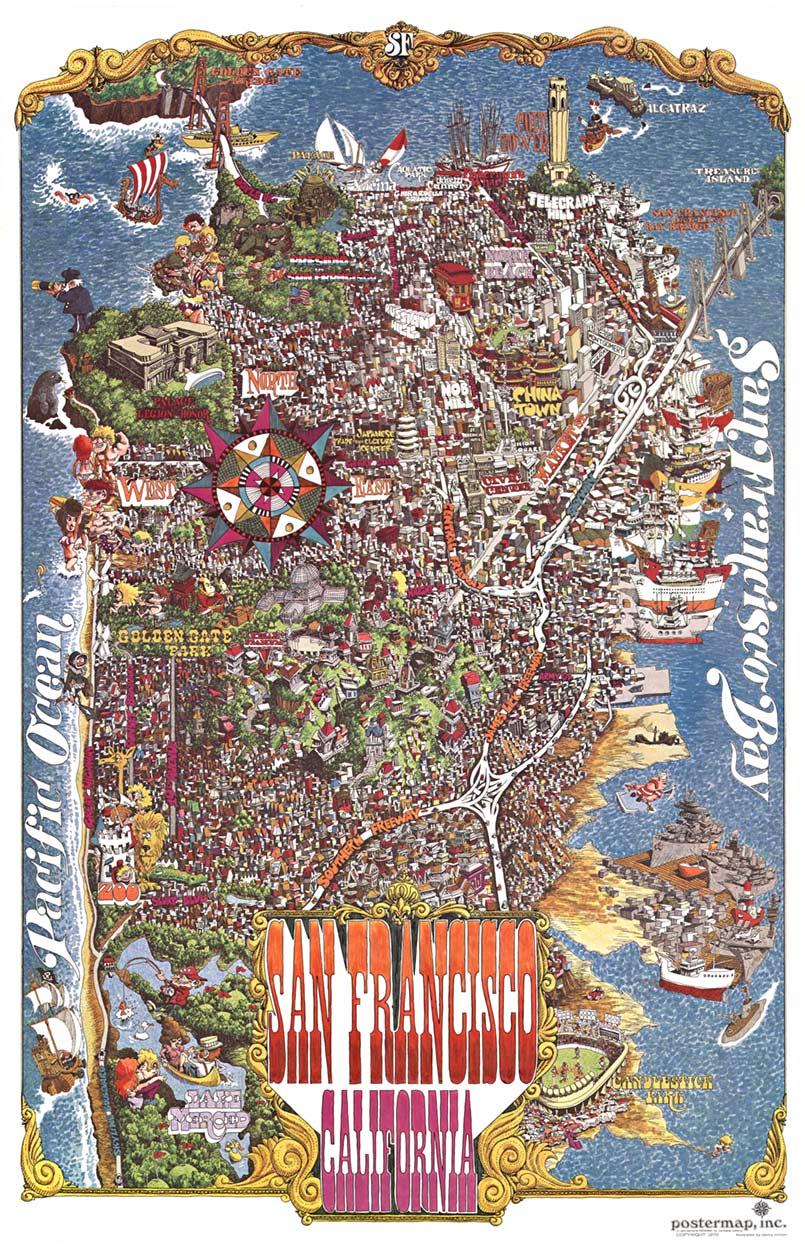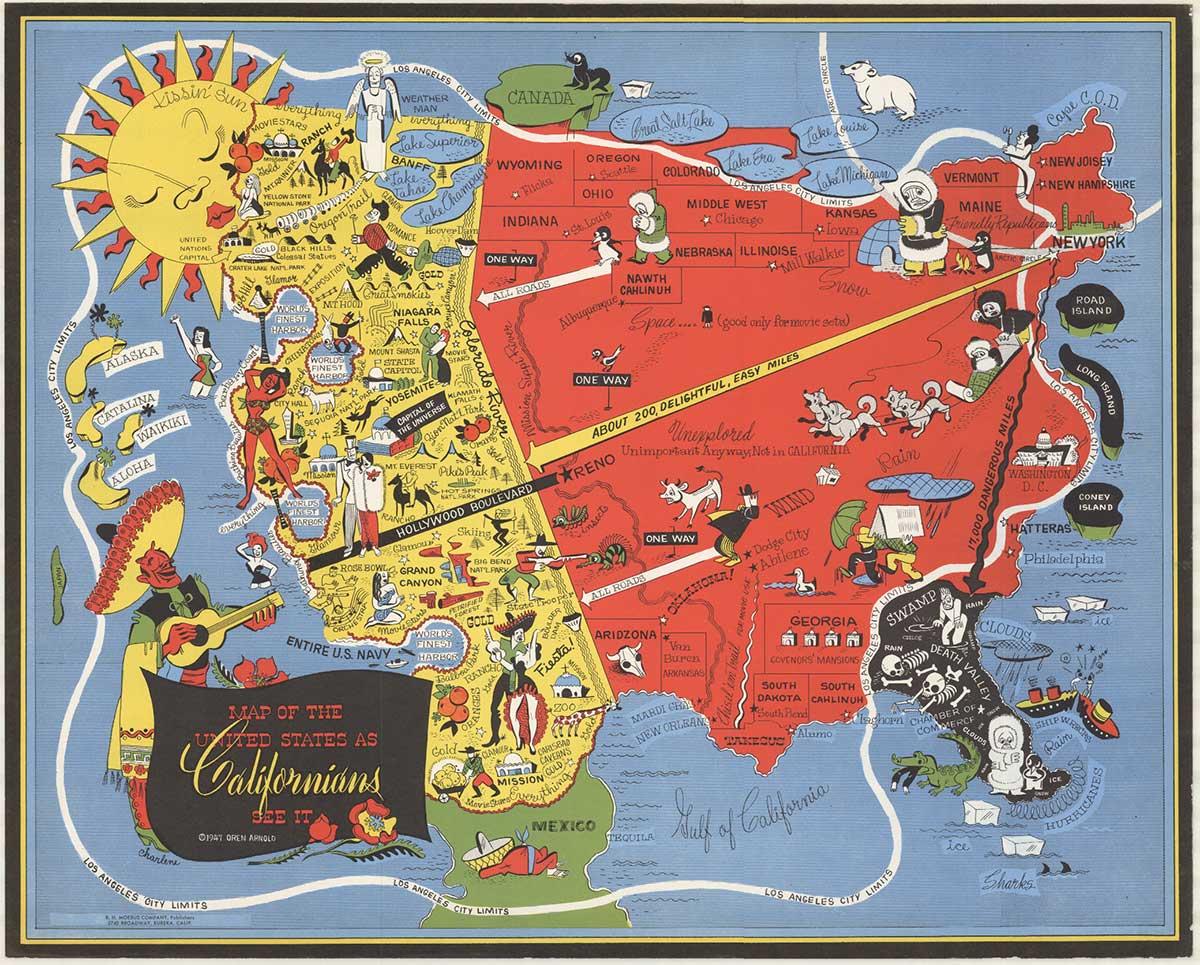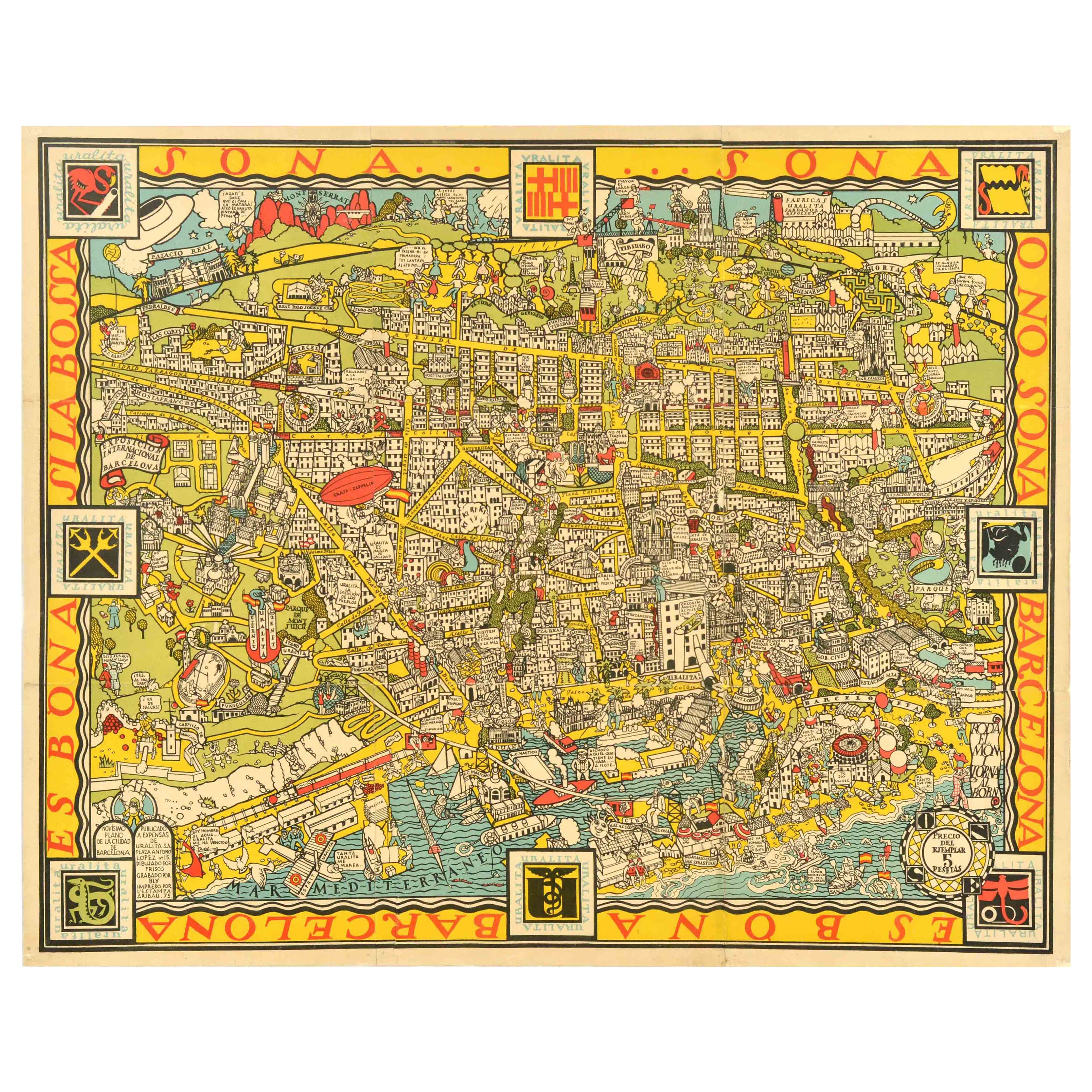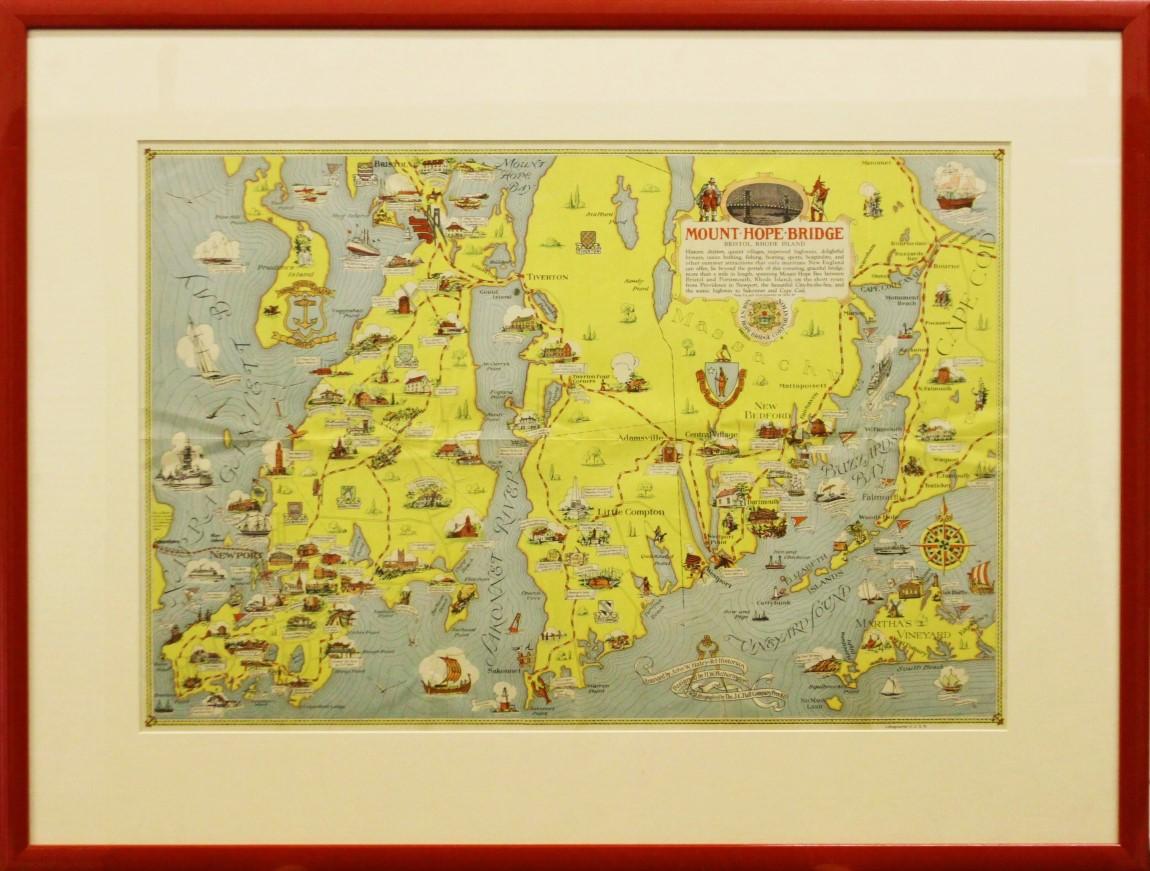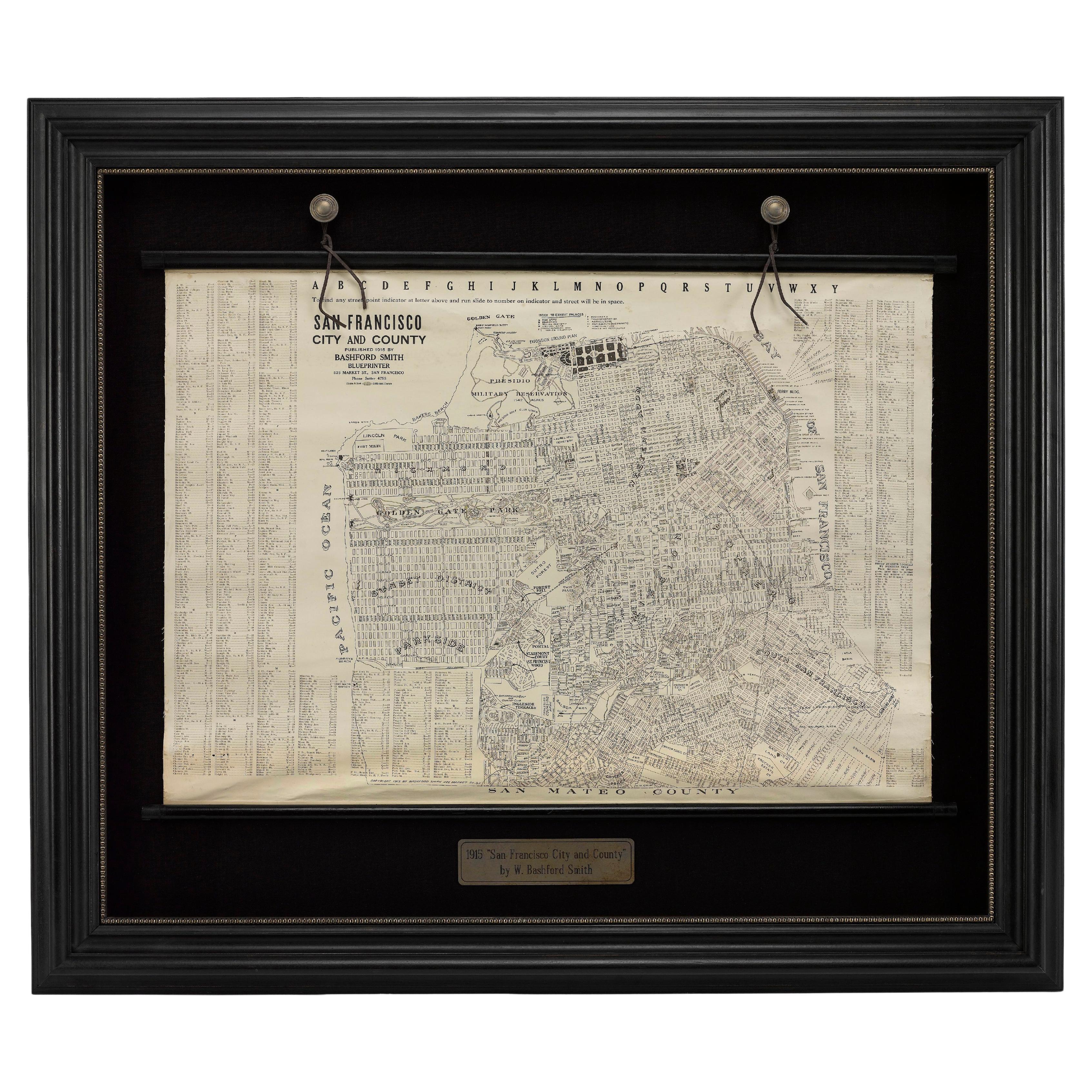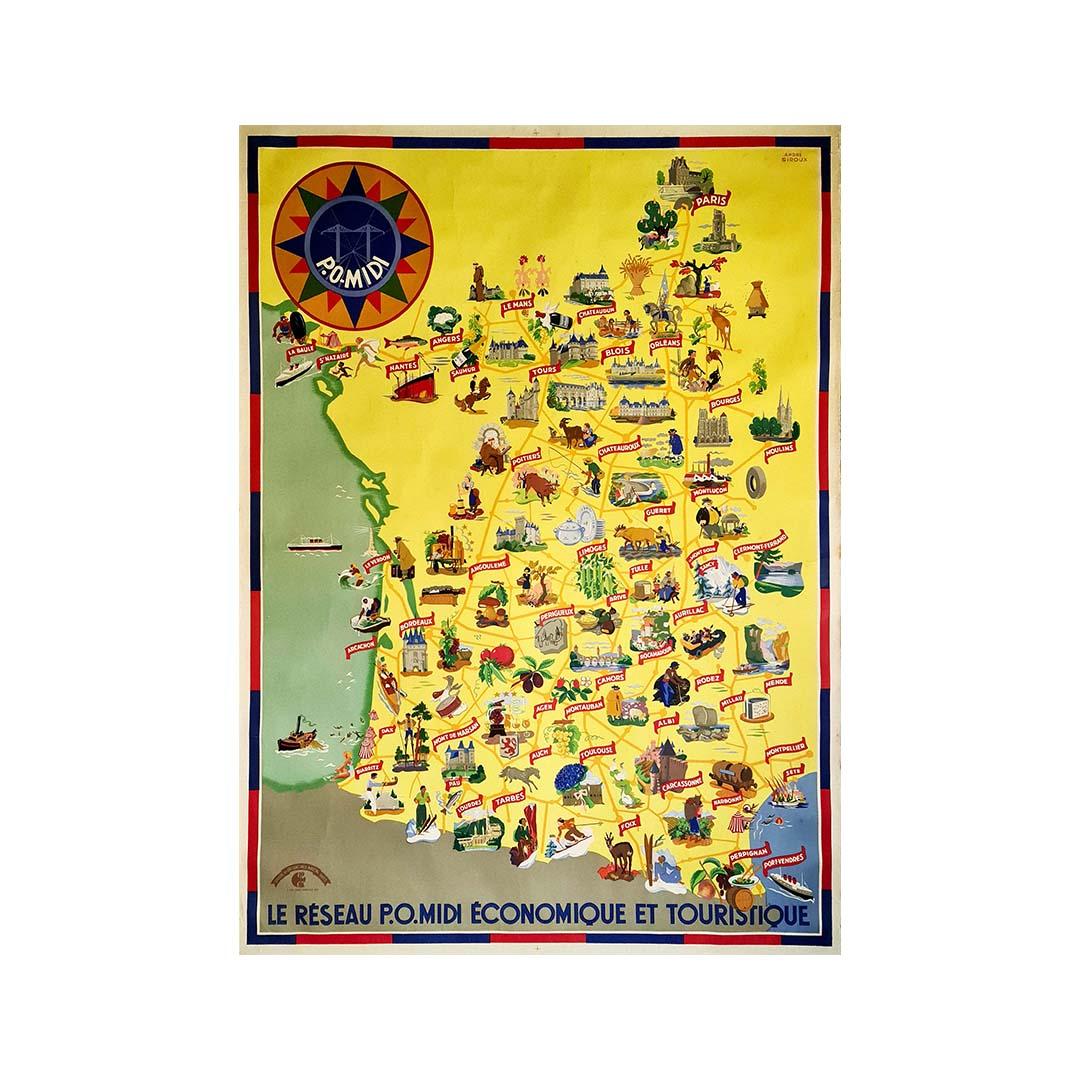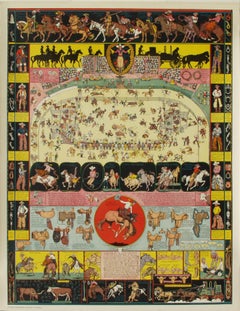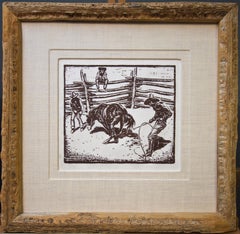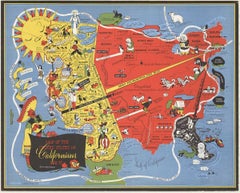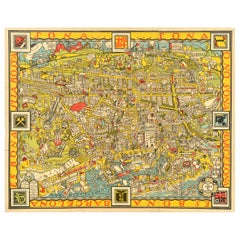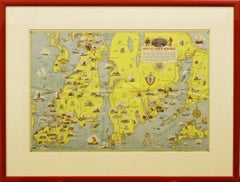Items Similar to Jo Mora's 1928 "Carte" of San Diego, Very Rare Pictorial Map
Want more images or videos?
Request additional images or videos from the seller
1 of 11
Joseph Jacinto MoraJo Mora's 1928 "Carte" of San Diego, Very Rare Pictorial Map1928
1928
$4,500
£3,398.22
€3,890.65
CA$6,355.18
A$6,938.33
CHF 3,637.48
MX$84,268.71
NOK 45,426.24
SEK 42,894.49
DKK 29,039.55
About the Item
Jo Mora's 1928 "Carte" of San Diego, Very Rare Pictorial Map
Size: 28 x 22.5 in (71.12 x 57.15 cm)
Every good condition for it's age
Originally came folded in envelope for mailing. Minor creasing is visible. Colors are unfaded.
It has normal wear for it's age, tiny crack in the fold in the center.
Comes with original envelope, it has deteriorated.
You are buying "as is"
SHIPPING CHARGES INCLUDE SHIPPING, PACKAGING & INSURANCE
This map was created by Jo Mora after he was commissioned by George Marston, Marston’s Department. The map was a commemorative for the store’s company. Limited to 2000 prints, the plates were destroyed afterwards. Examples are held in collection at several institutions such as University of California, San Diego and Denver Public Library.
Joseph Jacinto Mora 1876 – 1947
Mora was born in Montevideo, Uruguay, and was the son of Domingo Mora, a well-known painter and sculptor who brought his family to the United States in the mid 1890s and then became a teacher in New York at the Art Students League. Joseph and his artist brother Luis Mora (1874-1940) grew up being much influenced by the creative atmosphere of their father’s studio. In 1904, he returned to Arizona and New Mexico and lived with Hopi and Navajo tribes, learning their languages and painting depictions of their ceremonies, especially the Kachina ceremonial dances.
One of the results of his Western travels was a series of humorous maps that were spoofs of the national parks and that were made into posters. In the 1930s, the maps sold for 25 cents each and were distributed through souvenir shops at the parks. He also painted a watercolor series, “Horsemen of the West” and wrote two books, “Trail Dust and Saddle Leather” and “Californios.” Joseph Mora died in Pebble Beach on October 10, 1947. Devoting his life to exploration of subjects as diverse as vaqueros, Hopi Kachina figures, the Arizona landscape, and California missions, Joseph Mora also excelled as a writer, photographer, designer, children’s book illustrator, and map maker.
“Apart from the bread and butter commissions that he referred to as “pot-boilers,” Mora has left a vast legacy of fine artwork. His contributions to public sculpture and architectural decorations, which are numerous and diverse, gaze calmly at the world from buildings in Los Angeles, San Francisco, Salinas, San Jose and Portland. Mora’s dioramas and large-scale figures are permanently in Monterey and Sacramento, California and Claremore and Bartlesville, Oklahoma. His drawings, paintings and photographs are cherished in private collections and private institutions across the country and first editions of his books are highly valued. But in the final analysis, Mora’s most important works may be his cartes.
In these entertaining maps, Mora combined his encyclopedic knowledge of history, his writing, drawing, and cartooning skills, his fine sense of design, and his sense of playfulness to create an art form uniquely his own. Mora’s cartes are still captivating more than fifty years after their completion, and they exemplify the popular, entertaining, direct, and informative art at which Mora excelled.”
- Creator:Joseph Jacinto Mora (1876 - 1947, American)
- Creation Year:1928
- Dimensions:Height: 28 in (71.12 cm)Width: 22.5 in (57.15 cm)
- Medium:
- Period:
- Condition:
- Gallery Location:Phoenix, AZ
- Reference Number:1stDibs: LU2623215166182
About the Seller
No Reviews Yet
Vetted Professional Seller
Every seller passes strict standards for authenticity and reliability
1stDibs seller since 2023
6 sales on 1stDibs
- ShippingRetrieving quote...Shipping from: Phoenix, AZ
- Return Policy
Authenticity Guarantee
In the unlikely event there’s an issue with an item’s authenticity, contact us within 1 year for a full refund. DetailsMoney-Back Guarantee
If your item is not as described, is damaged in transit, or does not arrive, contact us within 7 days for a full refund. Details24-Hour Cancellation
You have a 24-hour grace period in which to reconsider your purchase, with no questions asked.Vetted Professional Sellers
Our world-class sellers must adhere to strict standards for service and quality, maintaining the integrity of our listings.Price-Match Guarantee
If you find that a seller listed the same item for a lower price elsewhere, we’ll match it.Trusted Global Delivery
Our best-in-class carrier network provides specialized shipping options worldwide, including custom delivery.More From This Seller
View AllIndians of North America 1936 by Jo Mora
Located in Phoenix, AZ
Indians of North America 1936
Jo Mora
Lithograph
Paper size: 31 7/8 x 24 1/4 inches
Image size; 30 1/4 x 22 7/8 inches
These are the original lithographs from the Jo Mora Estate from Jo Mora Jr.
THESE ARE NOT REPRODUCTIONS!
SHIPPING CHARGES INCLUDE SHIPPING, PACKAGING & INSURANCE
Joseph Jacinto Mora 1876 – 1947
Mora was born in Montevideo, Uruguay, and was the son of Domingo Mora, a well-known painter and sculptor who brought his family to the United States in the mid 1890s and then became a teacher in New York at the Art Students League. Joseph and his artist brother Luis Mora (1874-1940) grew up being much influenced by the creative atmosphere of their father’s studio. In 1904, he returned to Arizona and New Mexico and lived with Hopi and Navajo tribes, learning their languages and painting depictions of their ceremonies, especially the Kachina ceremonial dances. One of the results of his Western travels was a series of humorous maps that were spoofs of the national parks and that were made into posters. In the 1930s, the maps sold for 25 cents each and were distributed through souvenir shops at the parks. He also painted a watercolor series, “Horsemen of the West” and wrote two books, “Trail Dust and Saddle Leather” and “Californios.” Joseph Mora died in Pebble Beach on October 10, 1947. Devoting his life to exploration of subjects as diverse as vaqueros, Hopi Kachina figures, the Arizona landscape, and California missions, Joseph Mora also excelled as a writer, photographer, designer, children’s book illustrator, and map maker.
“Apart from the bread and butter commissions that he referred to as “pot-boilers,” Mora has left a vast legacy of fine artwork. His contributions to public sculpture and architectural decorations, which are numerous and diverse, gaze calmly at the world from buildings in Los Angeles, San Francisco, Salinas, San Jose and Portland. Mora’s dioramas and large-scale figures are permanently in Monterey and Sacramento, California and Claremore and Bartlesville, Oklahoma. His drawings, paintings and photographs are cherished in private collections and private institutions across the country and first editions of his books are highly valued. But in the final analysis, Mora’s most important works may be his cartes.
In these entertaining maps, Mora combined his encyclopedic knowledge of history, his writing, drawing, and cartooning skills, his fine sense of design, and his sense of playfulness to create an art form uniquely his own. Mora’s cartes are still captivating more than fifty years after their completion, and they exemplify the popular, entertaining, direct, and informative art at which Mora excelled.”
Betty Hoag McGlynn
• Original works by Maynard Dixon, Lon Megargee, Ed Mell, Fritz Scholder, Bill Schenck, Bill Lesch, Luis Jimenez, Greg
Singley, Dan Budnik, and other 20th century Western, WPA and Contemporary Southwestern artists.
• The Fine Art Estate of Lon Megargee
• Vintage rodeo...
Category
1930s Other Art Style More Prints
Materials
Lithograph
Jo Mora, Evolution of the Cowboy 1933, from Jo Mora Estate
Located in Phoenix, AZ
"LAST ONE IN MINT CONDITION"
Evolution of the Cowboy, 1933
Original Lithograph
Excellent condition, came directly from Jo Mora Jr.
Unframed!!
SHIPPING CHARGES INCLUDE SHIPPING, PACKAGING & INSURANCE
Original version was called Evolution of the Cowboy, 1933 or referred today as "Sweetheart of the Rodeo", Images from the poster were used for "Sweetheart of the Rodeo", the sixth album by American rock band the Byrds and was released on August 30, 1968. It was hated when released, today it is considered one of the great classics.
This is an original lithograph from the Jo Mora Estate from Jo Mora Jr.
Joseph Jacinto Mora (October 22, 1876 – October 10, 1947) was a Uruguayan-born American cowboy, photographer, artist, cartoonist, illustrator, painter, muralist, sculptor, and historian who wrote about his experiences in California. He has been called the "Renaissance Man of the West".
Early life
Mora was born on October 22, 1876, in Montevideo, Uruguay. His father was the Catalan sculptor, Domingo Mora, and his mother was Laura Gaillard Mora, an intellectual born in the Bordeaux region of France. His elder brother was F. Luis Mora, who would become an artist and the first Hispanic member of the National Academy of Design. The family entered the United States in 1880 and first settled in New York City, and then Perth Amboy, New Jersey.
Jo Mora 1931 Yosemite map
Jo Mora studied art at the Art Students League of New York and the Cowles Art School in Boston. He also studied with William Merritt Chase. He worked as a cartoonist for the Boston Evening Traveller, and later, the Boston Herald.
In the spring of 1903, Mora arrived in Solvang, California. He stayed at the Donohue Ranch. He made plans to travel to the Southwest to paint and photograph the Hopi. He spent time at the Mission Santa Inés; those photographs are now maintained by the Smithsonian Institution. Mora visited many Spanish missions in California that summer by horseback. He followed the "Mission Trail", also called the "Kings Highway".
In 1904, Mora visited Yosemite. Later, in 1904, to 1906, visited Arizona where he took photographs, painted and otherwise recorded the daily life of these Native Americans. Because the Hopi and other tribes have voiced their concerns more recently about photographs depicting religious ceremonies, the tribal nation should be contacted before they are used. He learned the Native languages and made detailed drawings of what he observed.
Career
In 1907, Mora wrote and illustrated the comic strip Animaldom.
In 1907, Mora returned to California and married Grace Needham. Their son, Joseph Needham Mora, was born on March 8, 1908. The Moras moved to San Jose, California, where Mora continued his work.
On 22 February 1911, the Native Sons of the Golden West Building, in San Francisco, with six terra cotta panels, by Domingo Mora and his son, Jo Mora, was dedicated.
In 1915, he served on the International Jury of Awards at the Panama–Pacific International Exposition and displayed six sculptures.[9]
In 1915-16 two of his sculptural commissions were revealed: the bronze memorial tablet with the profile of the late Archbishop Patrick W. Riordan for the Knights of Columbus and the Cervantes Monument in San Francisco's Golden Gate Park.[10][11] By 1919, he was sculpting for the Bohemian Club, including the Bret Harte Memorial plaque, completed in August 1919 and mounted on the outside of the private men's club building in San Francisco.
Carmel-by-the-Sea
In 1921, the Mora family relocated to Carmel-by-the-Sea, California, the largest art colony on the West Coast, making it their primary residence. He constructed a Craftsman-style home, which is located on the west side of San Carlos Street, the third house south of 1st Avenue.
Mora received a commission for the bronze and travertine Cenotaph, for Father Junípero Serra in the Memorial Chapel at the west end of Mission Carmel.
Mora was a director of the Carmel Art Association as early as 1934. His sculptures were exhibited between 1927 and 1934 in various galleries in Carmel.
Jo Mora is a serious sculptor, a responsible amateur actor; when mixed up with pen and ink, a humorist! Comic strips was once his trade. He was famous at it. That was years ago but his art of cartooning bloomed again when in recent years he produced the well known Mora Map of the Monterey Peninsula. Most successful with bronze statue creations which decorate many gardens in East and West. If he has a specialty in figures it is cowboys. He knows his West. Jo Mora will ever be famed for his portrayal of Pancho Lopez, The Bad Man, at Carmel Playhouse. He does everything well and is handsome while doing it. He is happily married-alas!
— Carmel Pine Cone
During the Great Depression, Mora created the "Carmel Dollar" as part of Carmel's program, offering unemployed residents scrip for public service, exchangeable for groceries and essentials; a three-cent stamp on the certificate's back acknowledged their efforts. When full, merchants accepted the certified scrip for goods or a dollar.
Architect Robert Stanton...
Category
1930s Other Art Style More Prints
Materials
Lithograph
Bronc by Lon Megargee, Woodblock Print ca. 1920s with Handmade Saguaro Rib Frame
Located in Phoenix, AZ
SHIPPING CHARGES INCLUDE SHIPPING, PACKAGING & **INSURANCE**
Bronc by Lon Megargee, Woodblock Print ca. 1920s
Handmade Saguaro Rib Frame, double linen mat, museum archival materials
Bronc
Woodblock Print, signed in print
Image: 8 3/4 x 9 7/8 inches
Frame: 21 x 20 inches
SHIPPING CHARGES INCLUDES, SHIPPING, PACKAGING & INSURANCE
FINE ART ESTATE OF LON MEGARGEE
Megargee Custom Handmade Saguaro Frame
We offer signed in print and original signature block prints. Custom, hand carved, signature frames, with archival standards and a speciality in hand dyed mats and french matting are provided for a beautiful and timeless presentation.
Free shipping Continental US
Biography
Megargee explored different mediums; printmaking captivated him in particular. The contrast of the black and white block print method captured perfectly his interpretation of a bold American West. The first print was produced around 1921 and culminated with the creation of “The Cowboy Builds a Loop” in 1933 with 28 images and poetry by his friend, Roy George. Megargee continued producing prints throughout the 1940s and early 50s.
Creator of the iconic logo for the Stetson Hat Company, " Last Drop From his Stetson", still in use today.
Fine Art Estate of Lon Megargee
At age 13, Lon Megargee came to Phoenix in 1896 following the death of his father in Philadelphia. For several years he resided with relatives while working at an uncle’s dairy farm and at odd jobs. He returned to Philadelphia in 1898 – 1899 in order to attend drawing classes at the Pennsylvania Academy of the Fine Arts. Back in Phoenix in 1899, he decided at the age of 16 to try to make his living as a cowboy. Lon moved to the cow country of Wickenburg where he was hired by Tex Singleton’s Bull Ranch. He later joined the Three Bar Ranch . . . and, after a few years, was offered a job by Billy Cook...
Category
Early 20th Century Figurative Prints
Materials
Woodcut
Hopi by Lon Megargee, Original Signed Block Print ca. 1920s
Located in Phoenix, AZ
Title: Hopi ca. 1920s
Artist: Lon Megargee
Medium: Block Print
Size: 11 x 11 inches (Sight Measurement)
SHIPPING CHARGES INCLUDE SHIPPING, PACKAGING & INSURANCE
Creator of Stetson's hat logo "Last Drop from his Hat"
Image of Lon Megargee not included in purchase.
Lon Megargee
1883 - 1960
At age 13, Lon Megargee came to Phoenix in 1896 following the death of his father in Philadelphia. For several years he resided with relatives while working at an uncle’s dairy farm and at odd jobs. He returned to Philadelphia in 1898 – 1899 in order to attend drawing classes at the Pennsylvania Academy of the Fine Arts. Back in Phoenix in 1899, he decided at the age of 16 to try to make his living as a cowboy.
Lon moved to the cow country of Wickenburg, Arizona where he was hired by Tex Singleton’s Bull Ranch. He later joined the Three Bar R. . . and after a few years, was offered a job by Billy Cook of the T.T. Ranch near New River. By 1906, Megargee had learned his trade well enough to be made foreman of Cook’s outfit.
Never shy about taking risks, Lon soon left Cook to try his own hand at ranching. He partnered with a cowpuncher buddy, Tom Cavness, to start the El Rancho Cinco Uno at New River. Unfortunately, the young partners could not foresee a three-year drought that would parch Arizona, costing them their stock and then their hard-earned ranch.
Breaking with his romantic vision of cowboy life, Megargee finally turned to art full time. He again enrolled at the Pennsylvania Academy of Art and then the Los Angeles School of Art and Design during 1909 – 1910. The now well-trained student took his first trip to paint “en plein air” (outdoors) to the land of Hopi and Navajo peoples in northern Arizona. After entering paintings from this trip in the annual Territorial Fair at Phoenix, in 1911, he surprisingly sold his first oil painting to a major enterprise – the Santa Fe Railroad . . . Lon received $50 for “Navajos Watching the Santa Fe Train.” He soon sold the SFRR ten paintings over the next two years. For forty years the railroad was his most important client, purchasing its last painting from him in 1953.
In a major stroke of good fortune during his early plein-air period, Megargee had the opportunity to paint with premier artist, William R. Leigh (1866 – 1955). Leigh furnished needed tutoring and counseling, and his bright, impressionistic palette served to enhance the junior artist’s sense of color and paint application. In a remarkable display of unabashed confidence and personable salesmanship, Lon Megargee, at age 30, forever linked his name with Arizona art history. Despite the possibility of competition from better known and more senior artists, he persuaded Governor George Hunt and the Legislature in 1913 to approve 15 large, historic and iconic murals for the State Capitol Building in Phoenix. After completing the murals in 1914, he was paid the then princely sum of roughly $4000. His Arizona statehood commission would launch Lon to considerable prominence at a very early point in his art career.
Following a few years of art schooling in Los Angeles, and several stints as an art director with movie studios, including Paramount, Megargee turned in part to cover illustrations for popular Western story magazines in the 1920s.
In the 1920s, as well, Lon began making black and white prints of Western types and of genre scenes from woodblocks. These prints he generally signed and sold singly. In 1933, he published a limited edition, signed and hard-cover book (about 250 copies and today rare)containing a group of 28 woodblock images. Titled “The Cowboy Builds a Loop,” the prints are noteworthy for strong design, excellent draftsmanship, humanistic and narrative content, and quality. Subjects include Southwest Indians and cowboys, Hispanic men and women, cattle, horses, burros, pioneers, trappers, sheepherders, horse traders, squaw men and ranch polo players. Megargee had a very advanced design sense for simplicity and boldness which he demonstrated in how he used line and form. His strengths included outstanding gestural (action) art and strong figurative work. He was superb in design, originality and drawing, as a study of his prints in the Hays collection reveals.
In 1944, he published a second group of Western prints under the same title as the first. Reduced to 16 images from the original 28 subjects, and slightly smaller, Lon produced these prints in brown ink on a heavy, cream-colored stock. He designed a sturdy cardboard folio to hold each set. For the remainder of his life, Lon had success selling these portfolios to museum stores, art fairs and shows, and to the few galleries then selling Western art.
Drawing on real working and life experiences, Lon Megargee had a comprehensive knowledge, understanding and sensitivity for Southwestern subject matter. Noted American modernist, Lew Davis...
Category
1920s American Impressionist Figurative Prints
Materials
Woodcut
High Wide and Handsome by Fletcher Martin 1953, Original Stone Lithograph
By Fletcher Martin
Located in Phoenix, AZ
SHIPPING CHARGES INCLUDE SHIPPING, PACKAGING & **INSURANCE**
Fletcher Martin
Size: 16 x12 inches
Stone lithograph
Frame 25 x 21 inches
High, Wide and Handsome- - 1953, Lithograph....
Category
1950s Contemporary Figurative Prints
Materials
Lithograph
Siesta by Lon Megargee 1929, Archival Pigmrnt Print
Located in Phoenix, AZ
Tequila Siesta
Lon Megargee
Archival Pigment Print
100% 300 gram cotton rag paper
Size: 22.5 x 27 inches
Paper size: 24 x 28.5 inches
Creator of the iconic logo for the Stetson Hat Company, " Last Drop From his Stetson", still in use today.
Fine Art Estate of Lon Megargee
At age 13, Lon Megargee came to Phoenix in 1896 following the death of his father in Philadelphia. For several years he resided with relatives while working at an uncle’s dairy farm and at odd jobs. He returned to Philadelphia in 1898 – 1899 in order to attend drawing classes at the Pennsylvania Academy of the Fine Arts. Back in Phoenix in 1899, he decided at the age of 16 to try to make his living as a cowboy. Lon moved to the cow country of Wickenburg where he was hired by Tex Singleton’s Bull Ranch. He later joined the Three Bar Ranch . . . and, after a few years, was offered a job by Billy Cook...
Category
1920s Figurative Prints
Materials
Archival Pigment
You May Also Like
Original San Francisco, California vintage fun map poster Henry Hinton
Located in Spokane, WA
Original San Francisco, California fun map vintage poster 1970. Archival linen backed in very fine condition, ready to frame.
-Artist: Henry Hinton
I don’t know how much more you could include in this detailed fun map of San Francisco...
Category
1970s American Impressionist Landscape Prints
Materials
Offset
Original 'Map of the United States as Californians See It' vintage map poster
Located in Spokane, WA
Original vintage poster: "Map of the United States as Californians See It". 1947, artist: Oren Arnold. Size: 16.5" x 20.5", R. H. MOEBUS COMPANY This poster is not linen-backed. This poster is in very good fine condition, ready to frame.
A humorous satirical pictorial map from 1947 with the golden sun on the upper left, gives a detailed depiction of California, its relative size to the rest of the United States, showing Florida as "Death Valley", the rest of the United States as "Unexplored" 'Unimportant anyway, not in California". The image has your Mexican singer; bikini-clad bathers and others set in the image. Shows rivers, lakes, harbors, landmarks, parks, recreational activities, and local people.
This map shows Los Angeles’ city...
Category
1940s American Modern Landscape Prints
Materials
Offset
$1,280 Sale Price
20% Off
Original Vintage Travel Map Poster Barcelona Map International Exposition Spain
Located in London, GB
Original vintage map poster for Barcelona Spain issued for the International Exposition of Barcelona held on Montjuic hill from 20 May 1929 to 15 January 1930 - Exposicion Internacio...
Category
Vintage 1920s Spanish Posters
Materials
Paper
"Rhode Island Map, 1933"
Located in Bristol, CT
Classic c1933 colour (12 fold) red framed map of Rhode Island designed by H.W. Hetherington from Narragansett Bay to Buzzard's Bay
Map Sz: 17 3/8"...
Category
1930s Prints and Multiples
Materials
Lithograph
1915 "San Francisco City and County" Hanging Map by W. Bashford Smith
Located in Colorado Springs, CO
Presented is a rare wall map of San Francisco by W. Bashford Smith. Published in San Francisco in 1915, this map indicates streets and city districts, and, most notably, shows the si...
Category
Vintage 1910s American Art Deco Maps
Materials
Wood, Paper
Circa 1935 map illustrated by André Giroux of the P.O Midi railroad network.
Located in PARIS, FR
Very beautiful map illustrated by André Giroux of the P.O Midi railroad network.
The railway company from Paris to Orleans and the Midi (PO Midi) is the n...
Category
1930s Prints and Multiples
Materials
Paper, Lithograph, Linen
More Ways To Browse
Used Boilers
Antique Diorama
Pictorial Map
Monterey Antique
Antique Boilers
Antique Hopi Kachina
Andalusia Poster
Andy Warhol Car Poster
Banksy Dirty Funker
Blue Dog Original Prints
Boac Caribbean
Cadiz Poster
Claes Oldenburg Notes
Cote De Azur Poster
Damien Hirst Skateboard
Ddr Poster
Deborah Kass Oy
Dig For Victory Poster
